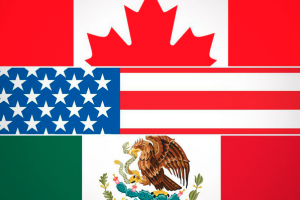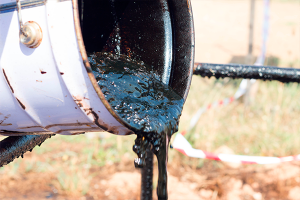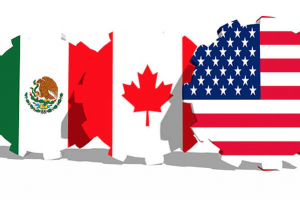Washington Post / Heather Long / October 1
Trump and Trudeau can tout this as a major victory ahead of key elections in their countries. It’s a lot less clear whether ‘NAFTA 2.0’ is good for Mexico and U.S. automakers.
The United States, Canada and Mexico finalized a sweeping new trade deal late Sunday, just hours before their Oct. 1 deadline. President Trump was up early Monday tweeting that the agreement is “a great deal for all three countries,” and Prime Minister Justin Trudeau said Sunday night that it was a “good day for Canada.”
The deal is expected to take effect around Jan. 1, 2020. Congress has to approve it, a process that will take months, but confirmation looks likely, given that Republicans are pleased Canada got on board and some Democrats are pleased with the stronger labor provisions.
Here’s a look at who’s smiling — and who’s not — as the world sees this news.
Winners:
President Trump. He got a major trade deal done and will be able to say it’s another “promise kept” to his voters right before the midterm elections. And he won the messaging game — he persuaded Canada and Mexico to ditch the name “NAFTA,” for North American Free Trade Agreement, which he hated, and to instead call the new agreement “USMCA,” for United States-Mexico-Canada Agreement. It’s not a total trade revolution, as Trump promised, but USMCA does make substantial changes to modernize trade rules in effect from 1994 to 2020, and it give some wins to U.S. farmers and blue-collar workers in the auto sector. Trump beat his doubters, and his team can now turn to the No. 1 trade target: China.
Prime Minister Justin Trudeau. There might not be a lot of love lost between Trump and Trudeau, but in the end, Trudeau didn’t cave much on his key issues: dairy and Chapter 19, the treaty’s dispute resolution mechanism. Trudeau held out and got what he wanted: Canada’s dairy supply management system stays mostly intact, and Chapter 19 remains in place, a win for the Canadian lumber sector. On dairy, Canada is mainly giving U.S. farmers more ability to sell milk protein concentrate, skim milk powder and infant formula. On top of the substantive issues, Trump went out of his way to criticize the Canadian negotiating team in the final days of deliberations, which Trudeau can play up as a sign of just how hard his staff fought on this deal.
Labor unions. This agreement stipulates that at least 30 percent of cars (rising to 40 percent by 2023) must be made by workers earning $16 an hour, about three times the typical manufacturing wage in Mexico now. USMCA also stipulates that Mexico must make it easier for workers to form unions. The AFL-CIO is cautiously optimistic that this truly is a better deal for U.S. and Canadian workers in terms of keeping jobs from going to lower-paying Mexico or to Asia, although labor is looking carefully at how the new rules will be enforced. It’s possible this could accelerate automation, but that would take time.
U.S. dairy farmers. They regain some access to the Canadian market, especially for what is known as “Class 7” milk products such as milk powder and milk proteins. The United States used to sell a lot of Class 7 products to Canada, but that changed in recent years when Canada started heavily regulating this new class. USMCA also imposes some restrictions on how much dairy Canada can export, a potential win for U.S. dairy farmers if they are able to capitalize on foreign markets.
Stock market investors. A major worry is over, and the U.S. stock market rallied Monday with the Dow gaining nearly 200 points.
Robert E. Lighthizer. Commerce Secretary Wilbur Ross and Treasury Secretary Steven Mnuchin couldn’t get major trade deals done for the president, but U.S. Trade Representative Lighthizer did. He led negotiations with South Korea on the revamped U.S.-South Korea trade deal (KORUS) that the president just signed, as well as on the “new NAFTA.” Lighthizer is proving to be the trade expert closest to Trump’s ear.
Losers:
China. Trump is emboldened on trade. A senior administration official said Sunday that the U.S.-Canada-Mexico deal “has become a playbook for future trade deals.” The president believes his strategy is working, and he’s now likely to go harder after China because his attention won’t be diverted elsewhere (at least on trade matters).
U.S. car buyers. Economists and auto experts think USMCA is going to cause car prices in the United States to rise and the selection to go down, especially on small cars that used to be produced in Mexico but may not be able to be brought across the border duty-free anymore. It’s unclear how much prices could rise (estimates vary), but automakers can’t rely as heavily on cheap Mexican labor now and there will probably be higher compliance costs.
Canadian steel. Trump’s tariffs on Canadian steel and aluminum remain in place for now, something Trudeau has called “insulting” since the two countries are longtime allies with similar labor standards.
Unclear:
Mexico. America’s southern neighbor kept a trade deal in place, but it had to make a lot of concessions to Trump. It’s possible this could stall some of Mexico’s manufacturing growth, and it’s unclear whether wages really will rise in Mexico because of this agreement. Big energy companies can also still challenge Mexico via Chapter 11, something that could constrain Mexico’s new government as it aims to reform energy policies.
Ford, GM, Chrysler and other big auto companies. There’s relief among auto industry executives that the deal is done, but costs will be high for big car companies: The steel tariffs are still in place on Canada; more car parts have to come from North America (not cheaper Asia); and more car components have to be made at wages of $16 an hour. It remains to be seen how car companies are able to adjust and whether this has long-term ramifications for their bottom lines.
Big business. Many business groups are relieved that Trump got a trilateral deal and didn’t end up tearing up NAFTA entirely, as he had threatened to do. And they like a lot of the trademark and patent provisions. But the details of USMCA include some losses for big business. Some regulatory compliance costs will probably rise, especially for automakers, and big business lost Chapter 11, the investor dispute settlement mechanism that companies have used to sue Canadian and Mexican governments (the one exception is that energy and telecommunications firms still get a modified Chapter 11 with Mexico).
Washington Post / Heather Long / October 1











